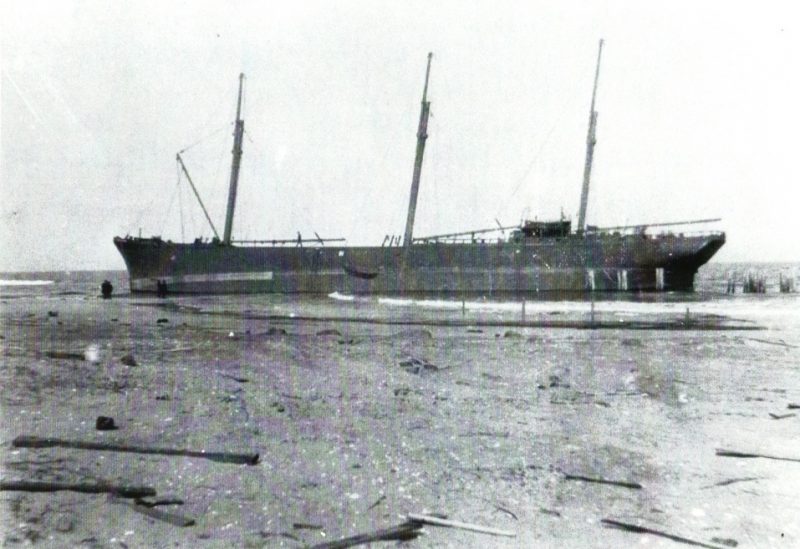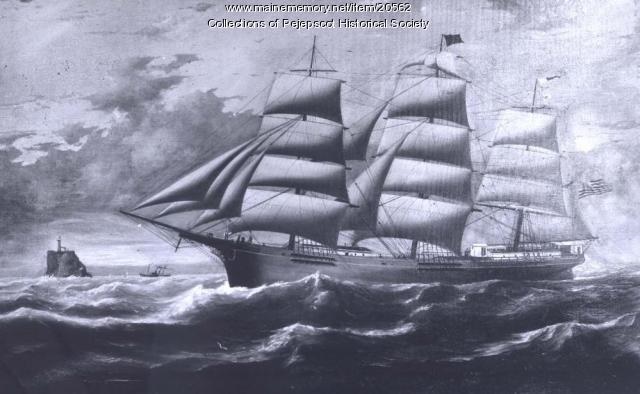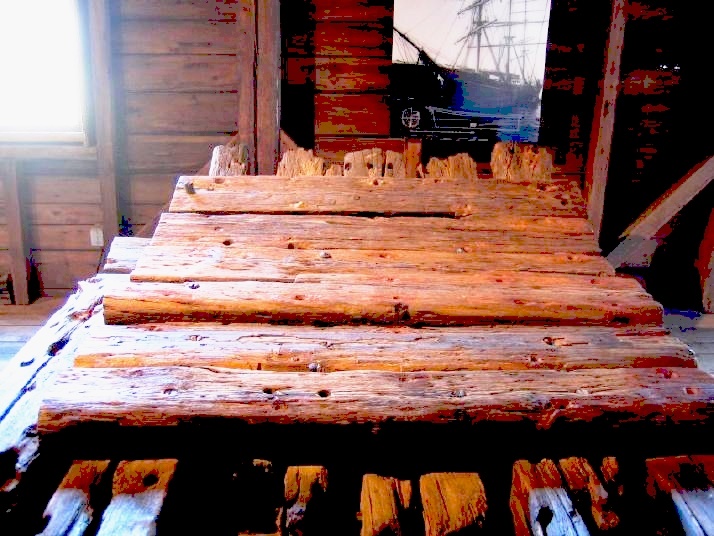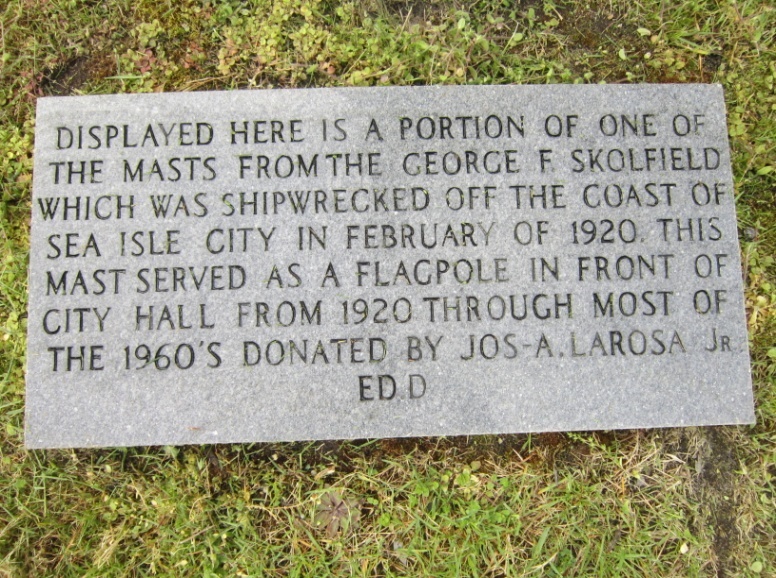A plaque tells of how a mast salvaged from the George R. Skolfield became the flagpole at Sea Isle's old City Hall and later at the Sea Isle Historical Museum.

 This painting depicts the 232-foot George R. Skolfield sailing ship during its 19th century heyday.
The George R. Skolfield:
Perhaps as a last hurrah, the Skolfield shipyard launched its largest-ever full-rigged ship in 1885 at a cost of nearly $88,000. Apparently in keeping with family tradition, she was named the George R. Skolfield – complete with George’s own carved likeness as the figurehead.
She was 232 feet long (about the same as a Boeing 747) and weighed in at 1,700 tons. Fittingly, her first voyage was an around-the-world trip. As the pride of the family’s fleet, the George R. regularly carried goods to and from the Orient, and visited ports in Australia, Hawaii, Europe, and the West Indies. But this wasn’t to last.
Her final voyage:
Although the George R. had begun life as a square-rigged sailing ship, she was later converted to a speedier three-masted schooner. A schooner was less expensive to operate, and was intended to compete with the new metal ships.
This painting depicts the 232-foot George R. Skolfield sailing ship during its 19th century heyday.
The George R. Skolfield:
Perhaps as a last hurrah, the Skolfield shipyard launched its largest-ever full-rigged ship in 1885 at a cost of nearly $88,000. Apparently in keeping with family tradition, she was named the George R. Skolfield – complete with George’s own carved likeness as the figurehead.
She was 232 feet long (about the same as a Boeing 747) and weighed in at 1,700 tons. Fittingly, her first voyage was an around-the-world trip. As the pride of the family’s fleet, the George R. regularly carried goods to and from the Orient, and visited ports in Australia, Hawaii, Europe, and the West Indies. But this wasn’t to last.
Her final voyage:
Although the George R. had begun life as a square-rigged sailing ship, she was later converted to a speedier three-masted schooner. A schooner was less expensive to operate, and was intended to compete with the new metal ships.
 An eight-foot section of the lower hull of the George R. Skolfield is on display at the Maine Maritime Museum. (Photo courtesy of Maine Maritime Museum)
Resurrection:
On September 10, 1971, a lady named Susan Langston spotted what appeared to be a large chunk of driftwood along the beach in Sea Isle. But it wasn’t exactly driftwood; it was what was left of the George R. Skolfield, newly exposed in the sand.
Even before she knew what she was dealing with, Ms. Langston began the tedious process of claiming the remains, and had them raised and moved on a flatbed truck to a friend’s back yard for storage. The piece weighed about ten tons.
Susan Langston was finally able to identify her find and to arrange for shipment to the Percy and Small Shipyard, a part of the Maine Maritime Museum, for exhibit close to where the human George R. had originally launched her.
(A detailed account of Ms. Langston’s adventure appeared in the American Institute of Nautical Archaeology Newsletter, Winter 1975. The Sea Isle Historical Museum has a copy).
Today, nearly 50 years later, an eight-foot section of the lower hull of the George R. is still on display at the Maine Maritime Museum. The piece is now 134 years old.
The mast and the flagpole:
It would be surprising if there aren’t some souvenirs of the ship still tucked away somewhere Sea Isle. The most public example of a relic is the top part of her mast used as the flagpole at the Sea Isle City Historical Museum.
The George R.’s mast didn’t just hop off the dying ship in 1920 and plant itself at the corner of the museum. It was first installed as the City Hall flagpole. Then it was used for forty years to anchor a clothesline at the LaRosa home on Central Avenue. Finally, in 2004, it was donated to the museum.
An eight-foot section of the lower hull of the George R. Skolfield is on display at the Maine Maritime Museum. (Photo courtesy of Maine Maritime Museum)
Resurrection:
On September 10, 1971, a lady named Susan Langston spotted what appeared to be a large chunk of driftwood along the beach in Sea Isle. But it wasn’t exactly driftwood; it was what was left of the George R. Skolfield, newly exposed in the sand.
Even before she knew what she was dealing with, Ms. Langston began the tedious process of claiming the remains, and had them raised and moved on a flatbed truck to a friend’s back yard for storage. The piece weighed about ten tons.
Susan Langston was finally able to identify her find and to arrange for shipment to the Percy and Small Shipyard, a part of the Maine Maritime Museum, for exhibit close to where the human George R. had originally launched her.
(A detailed account of Ms. Langston’s adventure appeared in the American Institute of Nautical Archaeology Newsletter, Winter 1975. The Sea Isle Historical Museum has a copy).
Today, nearly 50 years later, an eight-foot section of the lower hull of the George R. is still on display at the Maine Maritime Museum. The piece is now 134 years old.
The mast and the flagpole:
It would be surprising if there aren’t some souvenirs of the ship still tucked away somewhere Sea Isle. The most public example of a relic is the top part of her mast used as the flagpole at the Sea Isle City Historical Museum.
The George R.’s mast didn’t just hop off the dying ship in 1920 and plant itself at the corner of the museum. It was first installed as the City Hall flagpole. Then it was used for forty years to anchor a clothesline at the LaRosa home on Central Avenue. Finally, in 2004, it was donated to the museum.
 A plaque tells of how a mast salvaged from the George R. Skolfield became the flagpole at Sea Isle's old City Hall and later at the Sea Isle Historical Museum.
To take a look at the George R.’s mast, to learn more about early Sea Isle, and to browse through several thousand historic photos, visit the Sea Isle Historical Museum at 48th Street and Central Avenue. Access the website at www.seaislemuseum.com. Call 609-263-2992 with any questions. Hours are 10 a.m. to 3 p.m. on Monday, Tuesday, Thursday and Friday and from 10 a.m. to 1 p.m. on Saturday.
This “Spotlight on History” was written by Sea Isle City Historical Society volunteer Bob Thibault.
A plaque tells of how a mast salvaged from the George R. Skolfield became the flagpole at Sea Isle's old City Hall and later at the Sea Isle Historical Museum.
To take a look at the George R.’s mast, to learn more about early Sea Isle, and to browse through several thousand historic photos, visit the Sea Isle Historical Museum at 48th Street and Central Avenue. Access the website at www.seaislemuseum.com. Call 609-263-2992 with any questions. Hours are 10 a.m. to 3 p.m. on Monday, Tuesday, Thursday and Friday and from 10 a.m. to 1 p.m. on Saturday.
This “Spotlight on History” was written by Sea Isle City Historical Society volunteer Bob Thibault.